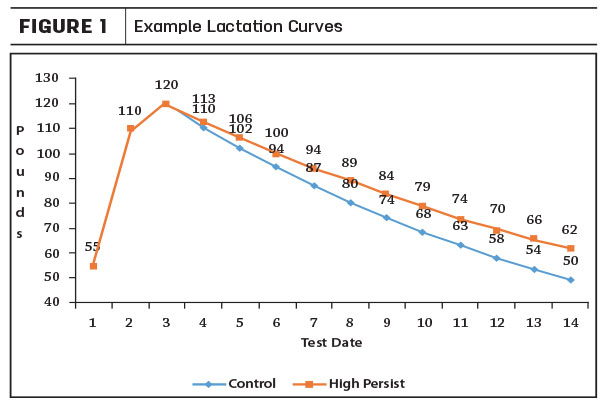As an industry there has rightly been a tremendous focus on the pre-fresh, post-fresh and on the first 90 days of lactation. This critical time period sets the pace for the whole lactation, and as a result, we’ve made significant improvements in fresh cow management, welfare, nutrition and performance, all of which combined have pushed peak milk to new heights.
Upon achieving peak milk, though, many animals are transitioned to late-lactation pens and put on autopilot until dry-off. As a result, peak milk could be declining at a faster rate than it would be otherwise. Identifying opportunities to slow the decline rate could be beneficial to profitability, and as simple as focusing on management basics.
On average, a first-lactation animal will experience peak milk decline at a rate of 5 to 6 percent per month, with animals in second or third lactations declining at a rate of 7 to 9 percent. If we can minimize this rate of decline by 2 percent, it can be a significant value in terms of milk capture, as illustrated by Figure 1.

In this example, two animals both peaked at 120 pounds of milk, with the high-performing animal declining in milk at 6 percent and the control declining at 8 percent. At the first measured decline, the control animal was only 3 pounds behind the high performer, but the gap in production steadily widens. By test day 14, the spread is at 12 pounds of milk, and the high-performing animal has out-produced the control by more than 2,665 pounds of milk, even though they peaked at the same level. If the value of this milk is 15 cents per pound, that would be $400 per cow.
You can see that even though we might have done everything right in the first 90 days to achieve a peak of 120 pounds of milk, there’s a lot of milk that can be lost in the next 200 to 250 days if we don’t focus on minimizing the rate of decline.
Some of the technologies we once relied on to help sustain peak milk performance, like rBST, are no longer available. So we now must rely on meticulous management and optimum nutrition to sustain peak milk persistency and improve late-lactation efficiency for the remaining 200 to 250 days.
To identify management and nutritional strategies to help slow the rate of milk decline, we need to understand what happens at the cellular level. Research indicates there is a genetic component to persistency; however, it cannot be overlooked at freshening. The cells in the milk gland are activated and begin producing milk, but over time cell proliferation slows and things like oxidative stress cause these cells to essentially shut down and stop producing milk. Once this happens, these cells can only be reactivated, or turned back on, the next time the cow freshens. So, even if we’ve done everything right in the pre-fresh and post-fresh period to prepare our animals by managing energy balance and maintaining immune system support, we can still rob them of milk if we don’t continue to pay careful attention to environmental management, nutritional management and feedbunk management.
When you look at the environment of your late-lactation animals, how does it compare to that of the fresh pens? Is the stocking density changing significantly, increasing competition for feed, water and resting time? What about the bedding and alley conditions? Are these being managed weekly in the fresh pens but bimonthly for late-lactation animals? Increased bacteria loads can increase demand on the immune system, and energy that would go toward production becomes diverted to other areas. While there is little research in later lactation, we know enough about dairy animals to conclude that maintaining a consistent, clean and comfortable environment throughout the whole lactation can help improve the rate that peak milk declines.
As we think about providing consistency throughout the whole lactation, we need to consider when we are making changes to the ration and what is the driving factor. Even if we are delivering the same nutrients, if the physical appearance and characteristics of the diet are changing, this can impact rumen health and overall performance.
Finally, are we continuing to manage the feedbunk as closely for late-lactation animals? Are they getting the right ration, delivered at the right time, or are they going hours without feed? At times, our tendency can be to focus too much on reducing feed costs in late lactation, and we miss the opportunity for marginal, and profitable, milk.
As common sense as these management areas might seem, it can be easy for many dairies to put these later-lactation animals on autopilot, without realizing how it might be impacting their bottom line. If you don’t currently know your rate of peak milk decline, I highly recommend you calculate it and compare it against the average to understand how much room for improvement, and milk capture, you have by focusing on this group of animals. Then look at the three management areas to determine where you might need to make adjustments. Work with your team of advisers to develop and implement needed changes, and then be sure to measure the results. Oftentimes, paying a little more attention to basic details can have big impacts. ![]()
PHOTO: Maintaining a consistent, clean and comfortable environment throughout the whole lactation can help improve the rate that peak milk declines. Staff photo.

-
Hank Spencer
- Cargill Animal Nutrition
- Email Hank Spencer






